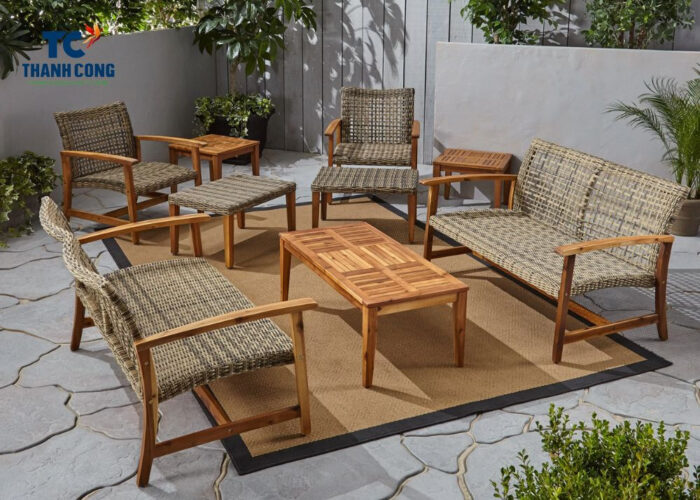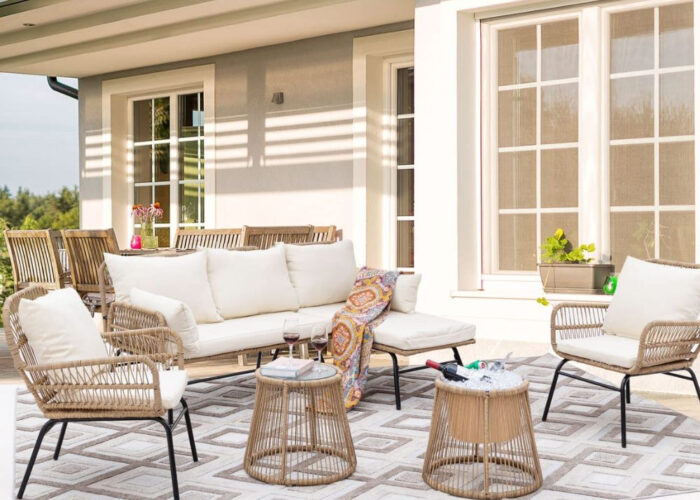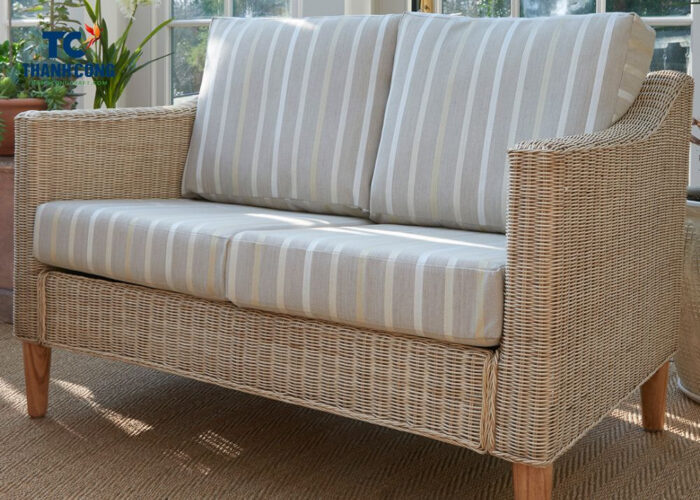Rattan, along with its variations like wicker, cane, and synthetic rattan (poly rattan, pe rattan), represents sturdy and enduring materials for fashioning furniture. Despite their durability, questions often arise regarding the water resistance of these materials, especially in the context of wicker furniture. This inquiry gains particular relevance when considering outdoor furniture, as its potential susceptibility to water exposure could initiate rapid deterioration. So, is rattan furniture waterproof?
Contents [hide]
1. Is rattan furniture waterproof?
Synthetic rattan is waterproof but natural rattan garden furniture can absorb moisture. If rattan furniture gets wet, it can lead to weakening, warping, and even mold or mildew growth.
Therefore, leaving rattan furniture in the rain is generally not recommended, especially if the furniture is made from natural rattan.
Conversely, synethtic rattan furniture is weather resistance, capable of enduring extended exposure to sunlight without any treatment, and it also provides substantial resilience against rain and frost. Not all rattan furniture is inherently weatherproof.
It’s important to note that not all rattan furniture is inherently weatherproof.

Synthetic materials are often more water-resistant than natural rattan, constant wet conditions can eventually lead to wear and tear, discoloration, and potential damage to the furniture’s frame and structure.
Remember to check the manufacturer’s recommendations for care and maintenance of your specific rattan furniture, as they may provide guidance on how to best protect it from rain and other weather conditions.
2. Types of rattan
There are two main types of rattan used in furniture making, both for indoor and outdoor use: natural rattan, synthetic rattan made from polyethylene (PE).
- Natural Rattan: Natural rattan is made from the natural fibers of the rattan plant, often from the Rattan species. They possess a natural beauty and provide a cozy ambiance to spaces. However, natural rattan is not water-resistant and can be damaged when exposed to water or humidity for extended periods.

- Synthetic Rattan (PE): Synthetic rattan is made from polyethylene (PE), a synthetic plastic material. Synthetic rattan has a similar appearance to natural rattan but is designed to be water-resistant and more capable of withstanding outdoor weather conditions. Due to the waterproof and durable nature of PE, synthetic rattan furniture is often preferred for outdoor use. Synthetic rattan is a material used for indoor or outdoor patio furniture, typically made from synthetic materials like PVC, nylon, or PE. Synthetic rattan can be designed to be water-resistant and capable of enduring harsh weather conditions. They often have a similar appearance and feel to natural rattan but may have higher durability and water-resistant properties.
When purchasing rattan furniture, it’s important to check the product information to accurately determine the type of rattan used and the related water-resistant and weather-resistant features.
3. What happens if rattan gets wet?
If natural rattan gets wet, it can lead to warping, mold growth, weakening, staining, discoloration, and even rotting over time.
- Natural rattan fibers readily absorb water. As the fibers take in moisture, they can swell and become distorted, leading to warping, bending, and changes in the furniture’s shape. This can result in an uneven or distorted appearance.
- Moisture weakens the structural integrity of natural rattan. Over time, the fibers can lose their strength, making the furniture more susceptible to breakage, cracks, and other forms of damage.
- Water exposure can cause natural rattan to become discolored. The wet areas may appear darker than the rest of the furniture, and this difference in color can be permanent if not properly addressed.
- The moisture absorbed by natural rattan creates a conducive environment for the growth of mold and mildew. This can lead to black or green spots on the furniture’s surface, resulting in stains, odors, and potential health concerns.
Prolonged exposure to moisture, especially in humid or damp environments, can lead to the deterioration of the rattan fibers. This can weaken the furniture’s overall structure and lifespan. The growth of mold and mildew on damp rattan can produce musty odors that are difficult to remove.
4. Can you waterproof rattan furniture?
While you can take steps to enhance the water resistance of natural rattan furniture, it’s important to note that completely waterproofing it can be challenging due to the material’s porous and natural characteristics. However, there are measures you can take to make your natural rattan furniture more water-resistant:
- Apply Sealants or Varnishes: Some individuals choose to apply a clear sealant or varnish specifically designed for natural materials like rattan. These products can create a protective barrier on the surface of the rattan, reducing its ability to absorb water. Keep in mind that sealants may alter the appearance of the rattan and might require periodic reapplication.
- Use Waterproof Outdoor Furniture Sprays: There are waterproofing sprays available that can provide a layer of protection against moisture. These sprays work similarly to sealants but are easier to apply and may have less impact on the appearance of the rattan.

- Furniture Wax: Applying furniture wax can create a temporary protective layer that helps repel water. However, this method might require more frequent reapplication.
- Keep It Covered: When not in use, consider using waterproof furniture covers to protect your natural rattan furniture from rain and humidity. This is especially important for outdoor furniture.
- Elevate the Furniture: If possible, elevate the furniture slightly off the ground to prevent direct contact with wet surfaces.
- Quick-Drying Cushions: If your rattan furniture has cushions, opt for cushions with quick-drying and water-resistant materials.
- Avoid Prolonged Exposure: Even with protective measures, avoid leaving your natural rattan furniture exposed to heavy rain or wet conditions for extended periods. If heavy rain is anticipated, consider moving the furniture indoors or to a covered area.
Remember that no method can make natural rattan furniture completely waterproof, and it’s crucial to strike a balance between enhancing its water resistance and maintaining its natural appearance. Experiment with small, inconspicuous areas before applying any treatments to the entire piece of furniture to ensure that you achieve the desired effect without compromising its look and feel.
The above article is the answer for the question: is rattan furniture waterproof and how to enhance its water resistance. If you have any further questions, please don’t hesitate to contact Thanhcongcraft via email at info@thanhcongcraft.com or Tel/WhatsApp: +84967485411. Hope to serve you soon! Best regard!
Don’t forget to check out our Rattan furniture!


